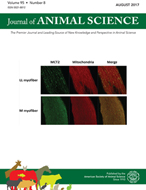-
Views
-
Cite
Cite
B. A. Young, Cold Stress as it Affects Animal Production, Journal of Animal Science, Volume 52, Issue 1, January 1981, Pages 154–163, https://doi.org/10.2527/jas1981.521154x
Close - Share Icon Share
Summary
Almost two-thirds of all livestock in North America are raised in regions where the mean January temperature is below O C. The effects of cold conditions on productivity and efficiency of feed conversion by swine, dairy and beef cattle are reviewed. Swine are rather cold-susceptible and are therefore usually kept in heated housing when raised in colder regions. Lactating or fattening cattle are extremely cold-hardy and rarely experience climatic conditions below their lower critical temperature. Despite the absence of a challenge to homothermy in cattle, there are marked seasonal fluctuations in the cattle's level and efficiency of production which probably arise from hormonal and adaptive changes occurring as a consequence of mild cold stress. Primary among these changes are an increased resting metabolic rate, and hence an increased energy requirement for maintenance, and an increased rate of passage of digesta, which results in reduced digestive efficiency. With cold there is stimulation of appetite, which may partially counteract the reduced level of production but not the reduced efficiency of utilization of dietary energy.





